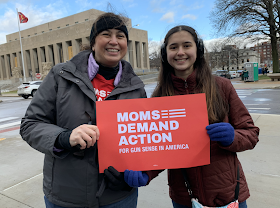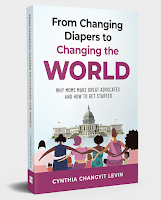 |
| 2017 March for Science in Washington D.C. |
When a big moment comes around, protests can be a powerful way for a local community to weigh in together or for individuals to congregate in a high-profile destination like Washington D.C. I’ll be the first to admit that protests are not the form of advocacy I have the most experience doing. Most people know that my focus is on relationship-building lobby meetings on the opposite side of the spectrum from shouting in the streets. There are times, however, when many voices need to be heard all at once.
As parents, we need to decide when it is appropriate to involve our children in protest activities. We must recognize that these experiences are not set up to be learning exercises for our children. Large crowds, uncomfortable temperatures, and heightened emotions provide challenging situations for both adults and children. Yet depending upon the issue, it can be just too important for us to stay away. Jennifer Burden of New Jersey shared this sentiment with TAPinto.net about her decision to attend a Black Lives Matter protest with her husband and two daughters:
“The movement to end racism is a social justice issue that my family finds important and wants to be a part of. The Black Lives Matter rally, here, in our town of Holmdel, was a great conduit to further our conversations with our kids on the topic of race, and it provided an opportunity, as parents, to model the positive behavior for them on standing up for those who need it most.”I want to make a clear statement that protesting is not the same as rioting. The right to protest is a protected right and a patriotic tradition in the United States. While it's true that some protest activities can lead to violence and property damage, rioting is not what I’m talking about.
 |
| A pre-coronavirus picture on the way to the Women's March in January of 2020. |
Before a protest:
· Look for a protest during daylight hours for better visibility, greater probability of peaceful action, and less grumpy children;
· Choose a protest location allowing you to leave early without trouble if your child is tired or needs to use a bathroom;
· Talk to children about the event days ahead of time to help them understand the issue and have time to ask questions;
· Help kids make their own signs. (Thinking about what they want on their signs and how they want to express it can be part of their learning experience);
· Discuss the tone of the march. (The March for Science had a serious message about climate change and other science-based issues, but a light-hearted attitude. Black Lives Matter (BLM) protests have an urgent air of life-and-death, and older kids should behave knowing they're standing in solidarity with survivors of traumatic experiences.);
Here are some tips for taking kids to protest events compiled from my experiences and suggestions from my friends who are more experienced parent-protesters.
For everyone:
· Pack water and snacks;
· Prepare for the weather. (Hats and sunscreen in the summer, ponchos for rain, or warm gloves and other outerwear for early spring and winter);
· Wear good, comfortable shoes;
· Stay close to each other;
· Bring a bandana for each person (Useful for wiping a sweaty face with cool water or protecting from tear gas);
For young children:
· Dress kids in clothes with pockets and make sure important info is in the pockets. (Very important info like allergies and phone numbers could even be written on arms or on a key chain safety-pinned to kid’s clothes);
· Bring a light-weight sign for every 2-3 marchers to take turns when little ones tire of carrying it;
· Attend with another family with your kids’ friends for fewer complaints of boredom;
· Snacks, snacks, snacks;
For older kids:
· Agree to rules before you arrive. (For instance, “don’t go into the thick of the crowd.” Or, “be respectful and positive.”);
· Charge all cell phones & conserve battery for communication with each other;
· Carry ID;
· Wear glasses instead of contacts in case of tear gas;
· Have a designated meeting space a few blocks from the protest in case you get separated;
· Choose a spot where you can hear the speeches, if possible, so your kids can learn;
· Discuss how to behave if yelled at, harassed, threatened, or arrested OR if you see it happen to someone else;
· For sensitive human rights issues like Black Lives Matter, discuss what it means to be a good ally. (For instance, counsel white kids to follow Black leadership and not start chants on their own. Also, taking and posting smiling selfies at next to people in pain is in poor taste no matter how many people are doing it around you.);
· For sensitive issues, do not post pictures of local organizers & other protesters on social media which might lead them to be targeted by extremists. (This happens here in St. Louis, sometimes with fatal consequences);
If the last three points are alarming, that is exactly why we have to give serious consideration to safety. Not all marches are simply a walk in the park. I'll say it again: We must recognize that these experiences are not set up to be learning exercises for our children.
 |
| My teens and I practiced safe mask-wearing and social distancing at a Black Lives Matter protest during the COVID-19 pandemic |
· Wear face masks at all times. Consider not taking children under two years of age because the CDC does not recommend masks for toddlers under that age;
· Maintain a distance of at least six feet from everyone not in your family even if it means you can’t hear the speeches as well;
· Bring hand sanitizer and use it liberally;
· If people aren't using masks...leave;
· Isolate for two weeks after to ensure you don't spread the virus if you do contract it;
Note: When COVID-19 safety protocol is followed, protests are being shown to be low-risk activities. Note that low-risk isn't NO risk. Stay home if you or your children are at high-risk for the virus.
What other suggestions can you share in the comment section?

Image: Book cover

No comments:
Post a Comment